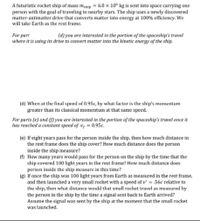Question
thumb_up100%

Transcribed Image Text:A futuristic rocket ship of mass m,hip = 6.0 × 10° kg is sent into space carrying one
person with the goal of traveling to nearby stars. The ship uses a newly discovered
matter-antimatter drive that converts matter into energy at 100% efficiency. We
will take Earth as the rest frame.
For part
where it is using its drive to convert matter into the kinetic energy of the ship.
(d) you are interested in the portion of the spaceship's travel
(d) When at the final speed of 0.95c, by what factor is the ship's momentum
greater than its classical momentum at that same speed.
For parts (e) and () you are interested in the portion of the spaceship's travel once it
has reached a constant speed of v, = 0.95c.
(e) If eight years pass for the person inside the ship, then how much distance in
the rest frame does the ship cover? How much distance does the person
inside the ship measure?
(f) How many years would pass for the person on the ship by the time that the
ship covered 100 light years in the rest frame? How much distance does
person inside the ship measure in this time?
(g) If once the ship was 100 light years from Earth as measured in the rest frame,
and then launched a very small rocket with a speed of v' = .56c relative to
the ship, then what distance would that small rocket travel as measured by
the person in the ship by the time a signal sent back to Earth arrived?
Assume the signal was sent by the ship at the moment that the small rocket
was launched.
Expert Solution
This question has been solved!
Explore an expertly crafted, step-by-step solution for a thorough understanding of key concepts.
Step by stepSolved in 3 steps with 2 images

Knowledge Booster
Similar questions
- A particle is created in a lab. Its kinetic energy is equal to its mass energy. If the particle travels a distance d before it decays, find an expression that shows how long the particle lived in its own rest frame.arrow_forwardWhat are the two postulates of special relativity? (Choose two answers.) A In any closed system, the total momentum will not change. B F=ma (c) The entropy of an isolated system will always increase over time. The speed of light is the same regardless of the speed of the observer or the speed of the source. Light travels to us from the hands of the clock. If we could move away from the clock at the speed of light, time will appear to stand still. If you measure both the position of a particle and its momentum, then the product of the F uncertainties of these two measurements must always be at least half of the reduced Planck's constant. For all possible paths between two points, the actual trajectory is the one that results in the action being minimized.arrow_forwardThere exista a spherical planet with a mass of M and a radius of R. How much energy is required to take a rocket of a mass m from rest on the surface of the planet to a circular orbit a height h above the surface?Find using the Energy Difference Ef -Ei where Ef is the energy in orbit and Ei is the energy at rest on the surface. h is not smallarrow_forward
- Two planets of mass 3 x 1025kg are release from rest 2.0 x 1012 m apart. What is the speed of the planets when they are half this distance apart?arrow_forwardFind the rest energy, in terajoules, of a 19.9 g piece of chocolate. 1 TJ is equal to 10'2 J. rest energy: TJarrow_forwardIn considering the energy supply for an automobile, the energy per unit mass of the energy source is an important parameter. The "heat of combustion" or stored energy per mass is quite similar for gasoline, ethanol, diesel fuel, cooking oil, methane, and propane. For a broader perspective, compare the energy per mass in joules per kilogram for gasoline, lead-acid batteries, hydrogen, and hay by stating the factor of increase between each one and the next. Hydrogen has "heat of combustion" 142 MJ/kg. For wood, hay, and dry vegetable matter in general, this parameter is 17 MJ/kg. A fully charged 17.0 kg lead-acid battery can deliver power 1450 W for 1.0 hr. (For comparison, the "heat of combustion" of gasoline is about 44 MJ/kg.) battery MJ/kg hay ✕ larger than battery energy/mass gasoline ✕ larger than hay energy/mass hydrogen ✕ larger than gasoline energy/massarrow_forward
arrow_back_ios
arrow_forward_ios